Territories of Contention: The Importance of Project Location in Mining-Related Disputes in Finland from the Geosystem Services Perspective
Abstract
1. Introduction
2. Geosystem Services, Land Use, and MMEDs
“the natural range (diversity) of geological (rocks, minerals, fossils), geomorphological (landform, processes) and soil features. It includes their assemblages, relationships, properties, interpretations and systems.”[38] (p. 8)
- Intrinsic value (free of human valuation);
- Cultural values (e.g., Uluru, Ayers Rock, Australia);
- Aesthetic values, i.e., geo-aesthetics [40] (e.g., Grand Canyon);
- Economic values (e.g., oil, coal, construction geomaterials, metals, gemstones);
- Functional values (e.g., geodiversity creates biodiversity);
- Scientific/educational values (e.g., Joggins Fossil Cliffs).
- Soil processes
- Biodiversity and habitat provision
- Land and water as platforms
- Burial and storage
- Food and drink
- Nutrients and minerals
- Energy sources
- Geomaterials
- Ornamental products
- Fossils for sale
- Environmental quality
- Geotourism and leisure
- Cultural, spiritual, and historical meaning
- Artistic inspiration
- Social development
- Earth history and geoheritage
- History of georesearch
- Environmental monitoring and forecasting
- Geoforensics
- Education and employment
3. Materials and Methods
4. Case Description
4.1. Hannukainen
4.2. Heinävesi
4.3. Juomasuo
4.4. Rompas–Rajapalot
4.5. Sakatti
4.6. Sokli
5. Analysis
Mining, Mineral Exploration, Land Use, and Geosystem Services
6. Conclusions
Funding
Data Availability Statement
Conflicts of Interest
References
- Roscoe, W.E. Probability of an exploration discovery in Canada. CIM Bull. 1971, 3, 134–137. [Google Scholar]
- Thomson, I.; Joyce, S.A. Mineral Exploration and the Challenge of Community Relations. On Common Ground Consultants Inc., 1997. Available online: http://oncommonground.ca/wp-content/downloads/mineral.html (accessed on 17 June 2020).
- Moon, C.J.; Evans, A.M. Ore, mineral economics and mineral exploration. In Introduction to Mineral Exploration, 2nd ed.; Moon, C.J., Whateley, M.K.G., Evans, A.M., Eds.; Blackwell Publishing: Hong Kong, China, 2006; pp. 3–18. [Google Scholar]
- Durán, A.P.; Rauch, J.; Gaston, K.J. Global spatial coincidence between protected areas and metal mining activities. Biol. Conserv. 2013, 160, 272–278. [Google Scholar] [CrossRef]
- Sonter, L.J.; Dade, M.C.; Watson, J.E.M.; Valenta, R.K. Renewable energy production will exacerbate mining threats to biodiversity. Nat. Commun. 2020, 1, 4174. [Google Scholar] [CrossRef] [PubMed]
- Owen, J.R.; Kemp, D.; Harris, J.; Lechner, A.M.; Lèbre, E. Fast track to failure? Energy transition minerals and the future of consultation and consent. Energy Res. Soc. Sci. 2022, 89, 102665. [Google Scholar] [CrossRef]
- Hilson, G. An overview of land-use conflicts in mining communities. Land-Use Policy 2002, 19, 65–73. [Google Scholar] [CrossRef]
- Badera, J. Problems of the social non-acceptance of mining projects with particular emphasis on the European Union—A literature review. Environ. Socio-Econ. Stud. 2014, 2, 27–34. [Google Scholar] [CrossRef]
- Conde, M. Resistance to mining. A review. Ecol. Econ. 2017, 132, 80–90. [Google Scholar] [CrossRef]
- Beland-Lindahl, K.; Johansson, A.; Zachrisson, A.; Viklund, R. Competing pathways to sustainability? Exploring conflicts over mine establishment in the Swedish mountain region. J. Environ. Manag. 2018, 218, 402–415. [Google Scholar] [CrossRef]
- Kivinen, S.; Kotilainen, J.; Kumpula, T. Mining conflicts in the European Union: Environmental and political perspectives. Fennia 2020, 198, 163–179. [Google Scholar] [CrossRef]
- Lesser, P. SLO Good Practices and Recent Disputes—Illustrative Examples across Europe. MIREU Project: Brussels, 2021; p. 136. Available online: https://mireu.eu/sites/default/files/2021-06/Illustrative%20Examples%20Report.pdf (accessed on 17 November 2022).
- Fjellborg, D.; Beland Lindahl, K.; Zachrisson, A. What to do when the mining company comes to town? Mapping actions of anti-extraction movements in Sweden. Resour. Policy 2022, 75, 102514. [Google Scholar] [CrossRef]
- Kangas, K.; Brown, G.; Kivinen, M.; Tolvanen, A.; Tuulentie, S.; Karhu, J.; Markovaara-Koivisto, M.; Eilu, P.; Tarvainen, O.; Similä, J.; et al. Land-use synergies and conflicts identification in the framework of compatibility analyses and spatial assessment of ecological, socio-cultural and economic values. J. Environ. Manag. 2022, 316, 115174. [Google Scholar] [CrossRef]
- Eerola, T. Corporate conduct, commodity, and place. Ongoing mining and mineral exploration disputes in Finland and their implications for the social license to operate. Resour. Policy 2022, 76, 102568. [Google Scholar] [CrossRef]
- Franks, D.M.; Davis, R.; Bebbington, A.J.; Ali, S.H.; Kemp, D.; Scurrah, M. Conflict translates environmental and social risk into business cost. Proc. Natl. Acad. Sci. USA 2014, 111, 7576–7581. [Google Scholar] [CrossRef]
- Jartti, T.; Litmanen, T.; Lacey, J.; Moffat, K. National level paths to the mining industry’s social licence to operate (SLO) in Northern Europe: The case of Finland. Extr. Ind. Soc. 2020, 7, 97–109. [Google Scholar] [CrossRef]
- Moffat, K.; Zhang, A. The paths to social license to operate: An integrative model explaining community acceptance of mining. Resour. Policy 2014, 39, 61–70. [Google Scholar] [CrossRef]
- Zhang, A.; Moffat, K.; Lacey, J.; Wang, J.; González, R.; Uribe, K.; Cui, L.; Dai, Y. Understanding the social licence to operate of mining at the national scale: A comparative study of Australia, China and Chile. J. Clean. Prod. 2015, 108, 1063–1072. [Google Scholar] [CrossRef]
- Komnitsas, K. Social license to operate in mining: Present views and future trends. Resources 2020, 9, 79. [Google Scholar] [CrossRef]
- Lesser, P.; Gugerell, K.; Poelzer, G.; Hitch, M.; Tost, M. European mining and the social license to operate. Extr. Industries. Soc. 2021, 8, 1–8. [Google Scholar] [CrossRef]
- Nicholls, W.; Miller, B.; Beaumont, J. (Eds.) Spaces of Contention: Spatialities and Social Movements, 1st ed.; Routledge: Aldershot, UK, 2013; p. 320. [Google Scholar]
- Suopajärvi, L. Social impact assessment in mining projects in Northern Finland: Comparing practice to theory. Environ. Impact Assess. Rev. 2013, 42, 25–38. [Google Scholar] [CrossRef]
- Lesser, P.; Suopajärvi, L.; Koivurova, T. Challenges that mining companies face in gaining and maintaining a social license to operate In Finnish Lapland. Miner. Econ. 2017, 30, 41–51. [Google Scholar] [CrossRef]
- Lassila, M.M. The Arctic mineral resource rush and the ontological struggle for the Viiankiaapa peatland in Sodankylä, Finland. Globalizations 2020, 18, 635–649. [Google Scholar] [CrossRef]
- Leino, J.; Miettinen, E. Mineral exploration, acceptance, and possibilities of participation—The case of Heinävesi mineral exploration conflict. Ympäristöoikeuden Vuosik. XIII 2020, 13, 265–367. (In Finnish) [Google Scholar]
- Guzik, K.; Galos, K.; Kot-Niewiadomska, A.; Eerola, T.; Eilu, P.; Carvalho, J.; Fernandez-Naranjo, J.V.; Arvidsson, R.; Arvanitidis, N.; Raaness, A. Potential benefits and constraints of development of critical raw materials’ production in the EU: Analysis of selected case studies. Resources 2021, 10, 67. [Google Scholar] [CrossRef]
- Beland-Lindahl, K.; Suopajärvi, L.; Poelzer, G.; Tulilehto, M.; Eerola, T. Social license to explore? Factors affecting local attitudes to mineral exploration and mining. Resour. Policy, 2022; submitted. [Google Scholar]
- Kaivosteollisuus ry, Mineral Exploration Meets the Need for Future Raw Materials. 2020. Available online: https://www.kaivosteollisuus.fi/fi/kaivosala-suomessa/malminetsinta-vastaa-tulevaisuuden-raaka-aineiden-tarpeeseen. (accessed on 25 June 2020). (In Finnish).
- Groves, D.I.; Santosh, M.; Müller, D.; Zhang, L.; Deng, J.; Yang, L.-Q.; Wang, Q.-F. Mineral systems: Their advantages in terms of developing holistic genetic models and for target generation in global mineral exploration. Geosyst. Geoenviron. 2022, 1, 100001. [Google Scholar] [CrossRef]
- Gray, M. Geodiversity: A new paradigm for valuing and conserving geoheritage. Geosci. Can. 2008, 35, 51–59. [Google Scholar]
- Gray, M. Other nature: Geodiversity and geosystem services. Environ. Conserv. 2011, 38, 271–274. [Google Scholar] [CrossRef]
- Van Ree, C.C.D.F.; van Beukering, P.J.H. Geosystem services: A concept in support of sustainable development of the subsurface. Ecosyst. Serv. 2016, 20, 30–36. [Google Scholar] [CrossRef]
- Van Ree, C.C.D.F.; van Beukering, P.J.H.; Boekestijn, J. Geosystem services: A hidden link in ecosystem management. Ecosyst. Serv. 2017, 26, 58–69. [Google Scholar] [CrossRef]
- Daily, G.C.; Matson, P.A.; Vitousek, P.M. Ecosystem Services Supplied by Soil; Island Press: Washington, DC, USA, 1997. [Google Scholar]
- Gray, M.; Gordon, J.E.; Brown, E.J. Geodiversity and the ecosystem approach: The contribution of geoscience in delivering integrated environmental management. Proc. Geol. Assoc. 2013, 124, 659–673. [Google Scholar] [CrossRef]
- Gray, M. Geodiversity: A significant, multi-faceted and evolving, geoscientific paradigm rather than a redundant term. Proc. Geol. Assoc. 2021, 132, 605–619. [Google Scholar] [CrossRef]
- Gray, M. Geodiversity: Valuing and Conserving Abiotic Nature; John Wiley & Sons: Chichester, UK, 2004. [Google Scholar]
- Sharples, C.A. Methodology for the Identification of Significant Landforms and Geological Sites for Geoconservation Purposes; Forestry Commission Tasmania: Tasmania, Australia, 1993. [Google Scholar]
- Eerola, T. Geoaesthetics: Art in GEOLOGY, geology in Arts. Pro-Geo 2008, 1, 1–4. Available online: http://www.progeo.ngo/downloads/PROGEO_news_2008_1.pdf (accessed on 30 September 2022).
- Garcia, M.G.M. Ecosystem services provided by geodiversity: Preliminary assessment and perspectives for the sustainable use of natural resources in the coastal region of the State of São Paulo, Southeastern, Brazil. Geoheritage 2019, 11, 1257–1266. [Google Scholar] [CrossRef]
- Perotti, L.; Carraro, G.; Giardino, M.; Luca, D.A.; Lasagna, M. Geodiversity evaluation and water resources in the Sesia Val Grande Unesco Geopark (Italy). Water 2019, 11, 2102. [Google Scholar] [CrossRef]
- Reverte, F.C.; Garcia, M.G.M.; Brilha, J.; Pellejero, A.U. Assessment of the impacts on ecosystem services provided by geodiversity in highly urbanised areas: A case study of Taubaté Basin, Brazil. Environ. Sci. Policy 2020, 112, 91–106. [Google Scholar] [CrossRef]
- Kubalikova, L. Cultural ecosystem services of geodiversity: A case study from Stránská skála (Brno, Czech Republic). Land 2020, 9, 105. [Google Scholar] [CrossRef]
- Tognetto, F.; Perotti, L.; Viani, C.; Colombo, N.; Giardino, M. Geomorphology and geosystem services of the Indren-Cimalegna area (Monte Rosa massif –Western Italian Alps). J. Maps 2021, 17, 161–172. [Google Scholar] [CrossRef]
- Chakraborty, A. Geodiversity and tourism sustainability in the Anthropocene. Tour. Hosp. 2022, 3, 496–508. [Google Scholar] [CrossRef]
- Tukiainen, H.; Hjort, J. Landscape-scale geodiversity in Finland. Terra 2021, 133, 55–76, (In Finnish, with English summary). [Google Scholar]
- Hanski, E.; Huhma, H. Central Lapland greenstone belt. In Precambrian Geology of Finland; Lehtinen, M., Nurmi, P.A., Rämö, O.T., Eds.; Key to the evolution of the Fennoscandian Shield. Developments in Precambrian Geology 14; Elsevier: Amsterdam, The Netherlands, 2005; pp. 139–194. [Google Scholar]
- Vanhanen, E. Geology, mineralogy and geochemistry of the Fe-Co-Au-(U) deposits in the Paleo-Proterozoic Kuusamo Schist Belt, northeastern Finland. Geol. Surv. Finl. Bull. 2001, 399, 283. [Google Scholar]
- Niiranen, T. Iron Oxide-Copper-Gold Deposits in Finland: Case studies from the Peräpohja schist belt and the Central Lapland Greenstone Belt. Ph.D. Thesis, No. 187 of the Department of Geology. University of Helsinki, Helsinki, Finland, 2005. [Google Scholar]
- Eilu, P. Overview on Gold Deposits in Finland. In Mineral Deposits of Finland; Maier, W.D., O’Brien, H., Lahtinen, R., Eds.; Elsevier: Amsterdam, The Netherlands, 2015; pp. 377–403. [Google Scholar]
- Brownscombe, W.; Ihlenfeld, C.; Coppard, J.; Hartshorne, C.; Klatt, S.; Siikaluoma, J.; Herrington, R.J. The Sakatti Cu-Ni-PGE Sulfide Deposit in Northern Finland; Maier, W.D., O’Brien, H., Lahtinen, R., Eds.; Elsevier: Amsterdam, The Netherlands, 2015; pp. 211–252. [Google Scholar]
- Puronaho, L. Structural Interpretation of Graphite-Bearing Black Schist in Aitolampi Area, Eastern Finland. Master’s Thesis, Åbo Akademi University, Turku, Finland, 2018; 64p. [Google Scholar]
- Vartiainen, H. The petrography, mineralogy and petrochemistry of the Sokli Carbonatite Massif, northern Finland. Geol. Surv. Finl. Bull. 1980, 313, 126p. [Google Scholar]
- European Commission, 2021. Natura. 2000. Available online: https://ec.europa.eu/environment/nature/natura2000/index_en.htm (accessed on 7 March 2021).
- Conde, M.; Le Billon, P. Why do some communities resist mining projects while others do not? Extr. Ind. Soc. 2017, 4, 681–697. [Google Scholar] [CrossRef]
- Thomson, I.; Boutilier, R.G. The social license to operate. In SME Mining and Engineering Handbook; Darling, P., Ed.; Society for Mining, Metallurgy and Exploration: Littleton, CO, USA, 2011; pp. 1779–1796. [Google Scholar]
- Hast, S.; Jokinen, M. Reconciliation of livelihoods—Focus on mining, reindeer herding and nature-based tourism. In Mine in the Finnish Society; Mononen, T., Suopajärvi, L., Eds.; Lapin Yliopistokustannus: Vaajakoski, Finland, 2016; pp. 86–97. (In Finnish) [Google Scholar]
- Jokinen, M. When a mine divides a locality. In Kaivos Koettuna; Mononen, T., Björn, I., Sairinen, R., Eds.; Lapland University Press: Rovaniemi, Finland, 2018; pp. 156–160. (In Finnish) [Google Scholar]
- Similä, J.; Jokinen, M. Governing conflicts between mining and tourism in the Arctic. Arct. Rev. Law Politics 2018, 9, 148–173. [Google Scholar] [CrossRef]
- Hast, S. Incompatible Natural Resources? Academic Disstertation. Acta Electron. Univ. Lapponiensis 2021, 323, 167. Available online: https://lauda.ulapland.fi/bitstream/handle/10024/64872/Hast%20Sanna%202.pdf?sequence=1&isAllowed=y (accessed on 27 July 2022). (In Finnish, with English Summary).
- Hannukainen Mining. the Ore That Was Left in the Ground. 2021. Available online: https://www.hannukainenmining.fi/en/hannukainen-mining-values/history/ (accessed on 7 March 2021).
- Jokinen, M.; Tyrväinen, L. Attitudes of tourists in Ylläs and Levi towards Hnnukainen mine project and Kittilä mine. The mine project of Hannukainen—Report on environmental impact assessment. Northl. Mines Oy 2013, 32p. (In Finnish) [Google Scholar]
- Sairinen, R.; Tiainen, H.; Mononen, T. Talvivaara mine and water pollution. An analysis of a mining conflict in Finland. Extr. Ind. Soc. 2017, 4, 640–651. [Google Scholar] [CrossRef]
- Ruokangas, P.; Aula, M. The Opponents of the Mine Collected over 51 000 Signatures—“The Tourism of Ylläs Does Not Support Mine”. Yle Uutiset 17.9.2019. 2019. Available online: https://yle.fi/uutiset/3-10972977 (accessed on 12 July 2022). (In Finnish).
- Ruokangas, P. A Mining Company’s Poll: Most People from Kolari Support the Disputed Mine. Yle Uutiset 6.9.2020. 2020. Available online: https://yle.fi/uutiset/3-11392218 (accessed on 27 July 2022). (In Finnish).
- Lapin Liitto. The Geological Background Information of the Lapland Mountain Area. Lapin Liitto, Rovaniemi. 2007. 56p. Available online: https://www.lapinliitto.fi/wp-content/uploads/2020/11/Tunturi-Lapin-maakuntakaava-alueen-geologiset-taustatiedot.pdf (accessed on 27 July 2022). (In Finnish).
- Carvalho, J.; Galos, K.; Kot-Niewiadomska, A.; Gugerell, K.; Raaness, A.; Lisboa, V. A look at European practices for identifying mineral resources that deserve to be safeguarded in land-use planning. Resour. Policy 2021, 74, 102248. [Google Scholar] [CrossRef]
- TUKES. Hannukaisen kaivospiirin määrääminen, KaivNro K8126, TUKES, Rovaniemi, 18.9.2017, 73 s. 2017. Available online: https://tukes.fi/documents/5470659/16028695/Hannukainenkpp%C3%A4%C3%A4t%C3%B6sNETTIVERSIO.pdf/b8ab23ea-2cbb-f05b-9127-88944e5c477f/Hannukainenkpp%C3%A4%C3%A4t%C3%B6sNETTIVERSIO.pdf?version=1.0&t=1571584454000 (accessed on 24 July 2022).
- Kokkonen, T. “The Whole Saimaa Would be Polluted Due to Mine”—A Graphite Mine Project Raises Resistance in Heinavesi. Etelä-Saimaa 10.07.2018. 2018. Available online: https://www.esaimaa.fi/paikalliset/3810480 (accessed on 30 June 2022). (In Finnish).
- Luikku, S. The Planned Graphite Mine in Heinavesi Raises Opposition—“Now Mining Companies Can Get the Benefits and Disappear”. Apu 18.1.2019. 2019. Available online: https://www.apu.fi/artikkelit/heinavedelle-kaavailtu-grafiittikaivos-herattaa-vastustusta-nyt-kaivosyhtiot-voivat-ottaa-hyodyt-ja-haipya (accessed on 27 November 2021). (In Finnish).
- Tiirikainen, V. Mineral Exploration Is Performed Even in Protected Areas—A Dispute in Heinävesi Is Being Resolved in Court. Yle Uutiset 4.8.2021. 2021. Available online: https://yle.fi/uutiset/3-12046490 (accessed on 24 July 2022). (In Finnish).
- Persson, S.; Harnesk, D.; Islar, M. What local people? Examining the Gállok mining conflict and the rights of the Sámi population in terms of justice and power. Geoforum 2017, 86, 20–29. [Google Scholar] [CrossRef]
- Kallio, H. A Mining Company Opposed by Sámi People in Sweden Expands to Finland. Turun Sanomat 13.1.2016. 2016. Available online: https://www.ts.fi/uutiset/talous/841490/Ruotsissa+saamelaisten+vastustama+kaivosyhtio+laajentaa+Suomeen (accessed on 12 November 2019). (In Finnish).
- Suopajärvi, L.; Beland Lindahl, K.; Eerola, T.; Poelzer, G. Social aspects of business risk in the mineral industry—Political, reputational, and local acceptability risks facing mineral exploration and mining. Miner. Econ. 2022. [Google Scholar] [CrossRef]
- Lyytimäki, J.; Peltonen, L. Mining through controversies: Public perceptions and the legitimacy of a planned gold mine near a touristic destination. Land-Use Policy 2016, 54, 479–486. [Google Scholar] [CrossRef]
- Lipsanen, J. A Game Challenger’s Turn 4/2014 Luonnonsuojelija 2014, 16–20. Available online: https://issuu.com/luonnonsuojeluliitto/docs/ls0414 (accessed on 27 July 2022). (In Finnish).
- Mauranen, A.; Kalli, A.; Oksanen, H.; Bruun, O.; Hyvärinen, P. A Gold Hunger Dragon: Examining Dragon Mining Oy and Gold Mining Industry in Finland. p. 45. Hitaiden akatemia ja Maan ystävät ry, Helsink. 2014. Available online: https://maanystavat.fi/sites/default/files/kullanhimoinen_lohikaarme-netti-v1.0.pdf (accessed on 27 July 2022). (In Finnish).
- Pirttikoski, R. A Poll by a Mining Company: Mining Projects Are Rejected in Kuusamo, Clearly More Favorable Attitudes towards Them in Posio. Kaleva 03.04.2018. 2018. Available online: https://www.kaleva.fi/kaivosyhtion-kysely-kuusamossa-torjutaan-kaivoshan/1832509 (accessed on 28 July 2022). (In Finnish).
- Purunen, R. The Urban Plan Banning Mining in Kuusamo Is Rejected by the High Court—A mining Company Satisfied with the Decision. Kaleva 23.5.2019. 2019. Available online: https://www.kaleva.fi/kuusamon-kaivoshankkeen-kieltava-kaava-nurin-korke/1711409 (accessed on 27 July 2022).
- Väinönheimo, S.; Laivamaa, S.; Tervahauta, A.; Hänninen, S.; Flöjt, M. Conservation of Palokas and Rompas Is Not a New Project. Uutiset, Suomen luonnonsuojeluliiton Lapin piiri, 16.04.2020. 2020. Available online: https://www.sll.fi/lappi/2020/04/16/palokkaan-romppaan-suojelu-ei-ole-uusi-hanke/ (accessed on 8 July 2022). (In Finnish).
- Niskasaari, M. A Request for inquiry on Nature Conservationists Made by the Mineral Exploration Company Mawson Is Groundless. Suomen Luonto, 8.4.2016. 2016. Available online: https://suomenluonto.fi/uutiset/malminetsinta-mawsonin-tutkintapyynto-luonnonsuojelijoista-aiheeton/ (accessed on 17 July 2022). (In Finnish).
- Kallio, H. Mawson Would Advance the Rajapalot Mine Project on the Border of Rovaniemi and Ylitornio Counties. Lapin Kansa 17.12.2020. 2020. Available online: https://www.lapinkansa.fi/mawson-lahtee-viemaan-eteenpain-rajapalojen-kaivos/3197554 (accessed on 27 July 2022). (In Finnish).
- Suomen luonnonsuojeluliitto. Save Viiankiaapa from Mining. 2021. Available online: https://www.sll.fi/mita-me-teemme/kaivokset/nain-toimimme/ (accessed on 7 March 2021). (In Finnish).
- Ruokangas, P.A. Mining Company’s Plan in Sodankylä: A Mine Would Be Built below a Protected Area with a Five-Kilometer-Long Tunnel. Yle Uutiset 30.11.2020. 2020. Available online: https://yle.fi/uutiset/3-11672536 (accessed on 27 July 2022). (In Finnish).
- Suopajärvi, L.; Umander, K.; Jungsberg, L. Social license to operate in the frame of social capital exploring local acceptance of mining in two rural municipalities in the European North. Resour. Pol. 2019, 64, 101–498. [Google Scholar]
- Tuulentie, S.; Halseth, G.; Kietäväinen, A.; Ryser, L.; Similä, J. Local community participation in mining In Finnish Lapland and northern British Columbia, Canada—Practical applications of CSR and SLO. Resour. Pol. 2019, 61, 99–107. [Google Scholar] [CrossRef]
- Tulilehto, M.; Suopajärvi, L. Experienced Impacts of Mining in Sodankylä. Follow-up Study. University of Lapland: Rovaniemi, 2021; p. 31. Available online: https://lauda.ulapland.fi/bitstream/handle/10024/64813/Experienced%20Impacts%20of%20Mining%20in%20Sodankyl%c3%a4.pdf?sequence=1&isAllowed=y (accessed on 27 July 2022).
- Kotilainen, J.M.; Peltonen, L.; Reinikainen, K. Community Benefit Agreements in the Nordic mining context: Local opportunities for collaboration in Sodankylä, Finland. Resour. Policy 2022, 79, 102973. [Google Scholar] [CrossRef]
- Pohtila, T. The Sokli Mine Has Been Expected to be the Saviour of the Small Savukoski County for Already 50 Years—The Decision on Environmental Permit Will Be Issued at the Beginning of the Year. 2018. Available online: https://www.aamulehti.fi/uutiset/art-2000007287753.html (accessed on 28 July 2022). (In Finnish).
- Konttinen, M.; Passoja, A. Yara Gives up Sokli Mine Project and Sells It to the Finnish State. Yle Uutiset, 11.12.2020. 2020. Available online: https://yle.fi/uutiset/3-11692948 (accessed on 30 July 2022). (In Finnish).
- Kurko, A. The Disputed Sokli Mining Project Threatens the Fragile Nature and Reindeer Herding of Eastern Lapland. Voima, 9/2020. 2020. Available online: https://voima.fi/artikkeli/2020/kiistelty-soklin-kaivoshanke-uhkaa-ita-lapin-herkkaa-luontoa-ja-poronhoitoa/ (accessed on 27 July 2022).
- Tiihonen, J. The Supreme Court Returned the Environmental and Water Permit of the Sokli Mine to be Rehandled by the Regional State Administrative Agency. Yle Uutiset 24.3.2022. 2022. Available online: https://yle.fi/uutiset/3-12374821 (accessed on 28 October 2022).
- Konnunaho, J.; Eerola, T.; Karinen, T.; Niiranen, T.; Nykänen, V.; Rasilainen, K.; Salmirinne, H.; Törmänen, T.; Arvola, V. Mineral exploration and mineral potential of Eastern Lapland. In Ore Exploration and the Mineral Potential of Eastern Lapland and Their Regional Economic Impacts and Utilization in the Economic Life of the Region; Konnunaho, J., Eerola, T., Karinen, T., Niiranen, T., Nykänen, V., Rasilainen, K., Salmirinne, H., Törmänen, T., Arvola, V., Aarrevaara, T., et al., Eds.; GTK:n Tutkimustyöraportti 62/2021; 2021; pp. 10–83. Available online: https://tupa.gtk.fi/raportti/arkisto/62_2021.pdf (accessed on 24 October 2022)(In Finnish, with English summary).
- Leisti, T. The Sokli Mine Project Suffered a Great Setback but Drilling Proceeds—“What a Hell They Are Still Doing Here”, a Local Wonders. Yle Uutiset 2.8.2022. 2022. Available online: https://yle.fi/uutiset/3-12555027 (accessed on 30 July 2022).
- Haslam, P.A.; Tanimoune, N.A. The determinants of social conflict in the Latin American mining sector: New evidence with quantitative data. World Dev. 2015, 78, 401–419. [Google Scholar] [CrossRef]
- Van der Plank, S.; Walsh, B.; Behrens, P. The expected impacts of mining: Stakeholder perceptions of a proposed mineral sands mine in rural Australia. Resour. Policy 2016, 48, 129–136. [Google Scholar] [CrossRef]
- McGaurr, L.; Lester, L. Environmental groups treading the discursive tightrope of social license: Australian and Canadian cases compared. Int. J. Commun. 2017, 11, 3476–3496. [Google Scholar]
- Leonard, L.; Lebogang, T. Exploring the impacts of mining on tourism growth and local sustainability: The case of Mapungubwe Heritage Site, Limpopo, South Africa. Sust. Dev. 2018, 26, 206–216. [Google Scholar] [CrossRef]
- Goodland, R. Responsible mining: The key to profitable resource development. Sustainability 2012, 4, 2099–2126. [Google Scholar] [CrossRef]

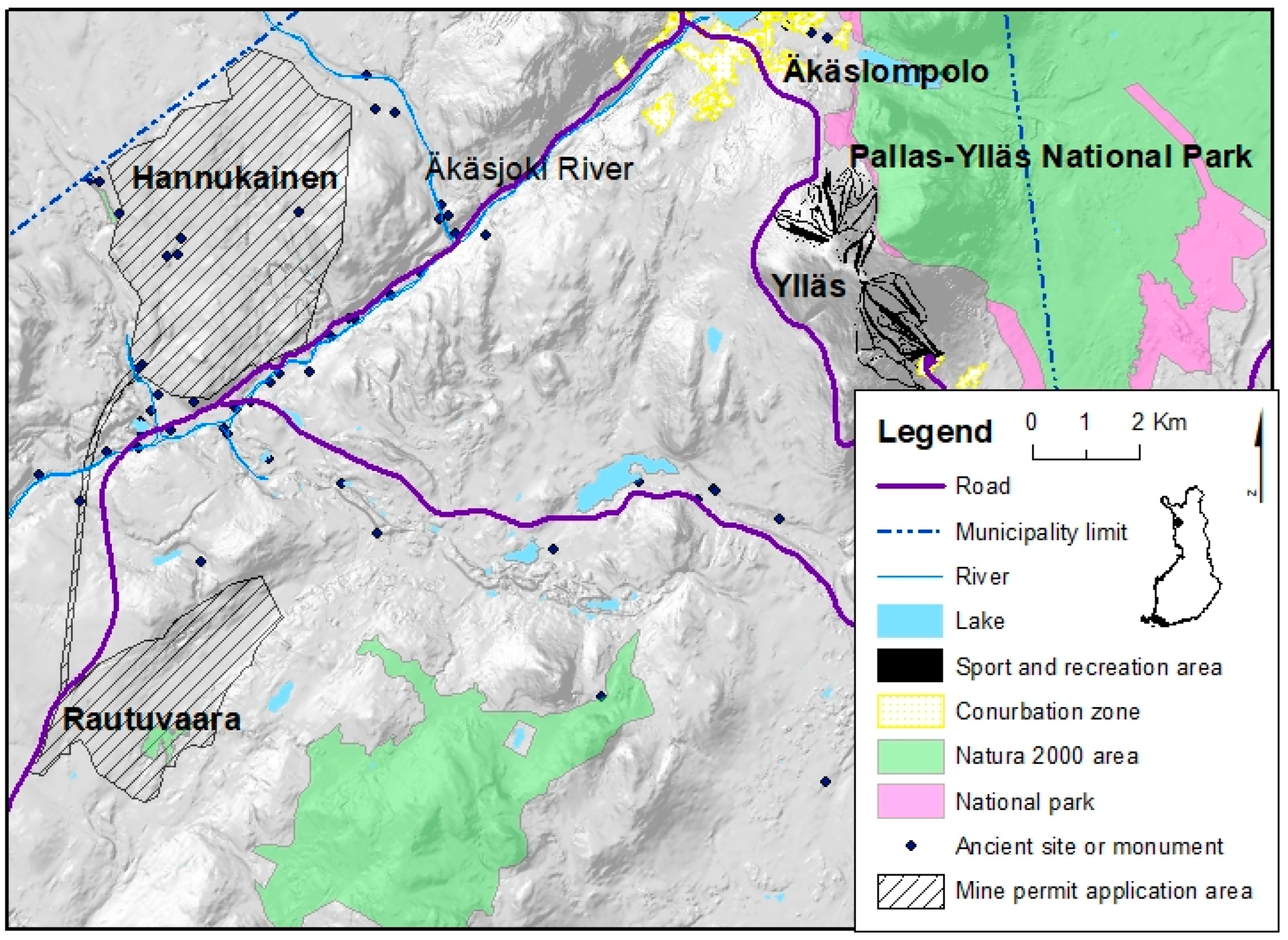
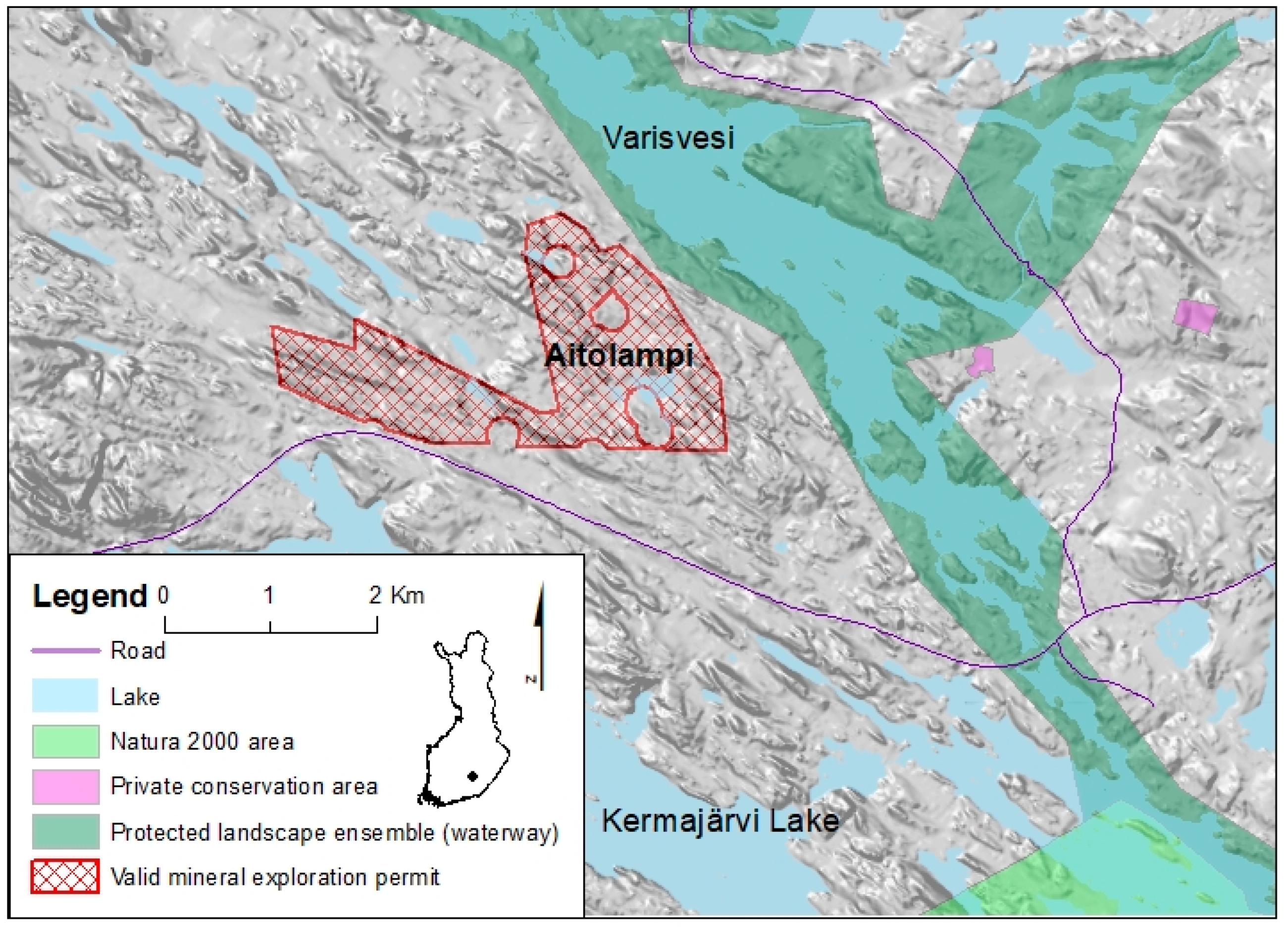
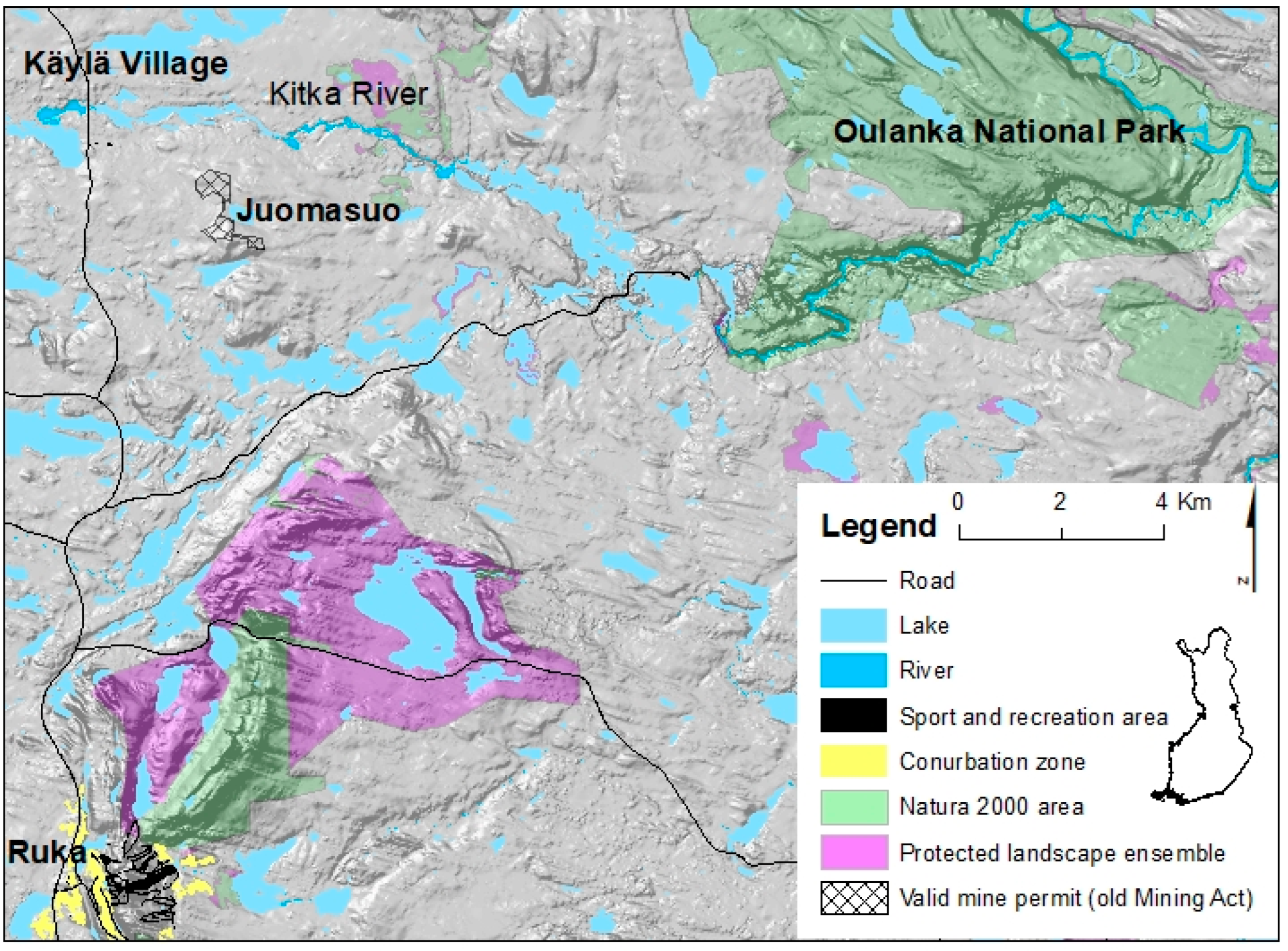
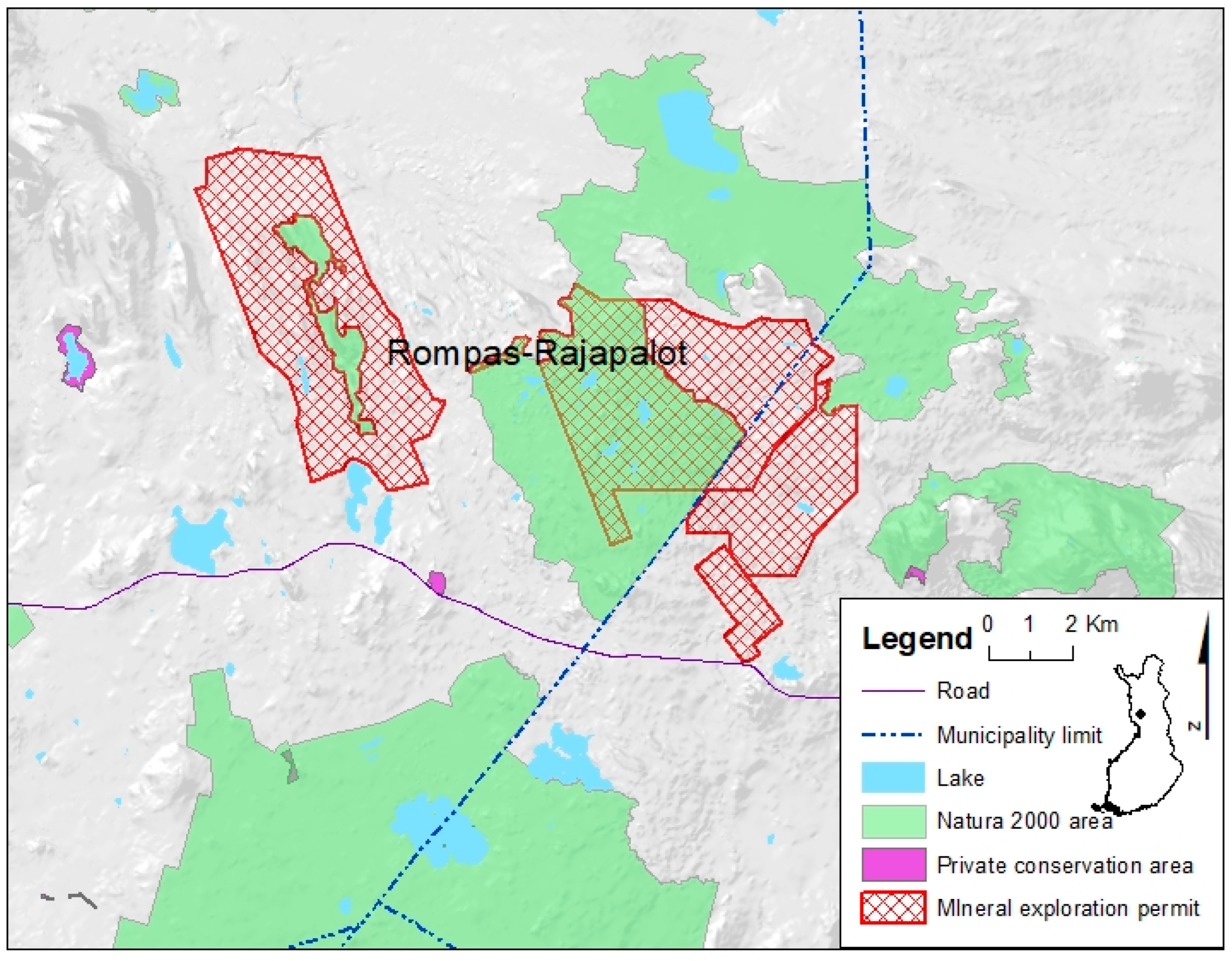

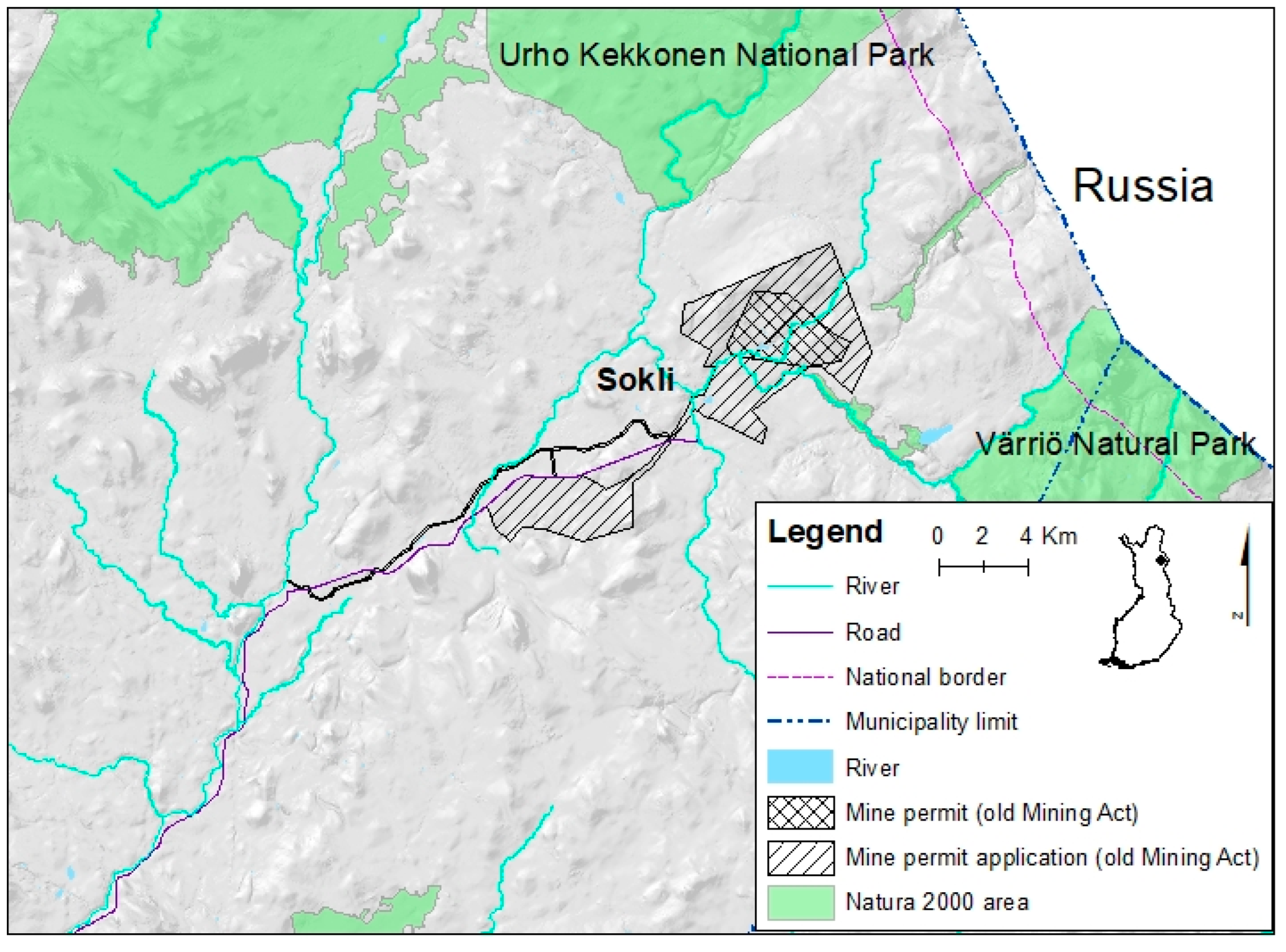
| Project/Locality and Commodities | Company/Parent Company | Issue(s)/Concerns | Indicator(s) | Main Contentious Actor(s) |
|---|---|---|---|---|
| Aitolampi/Heinävesi, Rääpysjärvi/Tuusniemi, mineral exploration: graphite | Grafintech Oy/Beowulf Ltd. | Saimaa Lake area, cottages, tourism, reputation | Ref. [26], organized movements, social media group, petition | Pro Heinävesi movement |
| Hannukainen/Kolari, mine project: iron, copper, gold, cobalt | Hannukainen Mining Oy/Tapojärvi Oy | Tourism, reindeer herding, PAs | Ref. [24], organized movement, social media group, petition | Pro Ylläs association, cottage owners |
| Juomasuo/Kuusamo, mine project: gold, cobalt (uranium) | Latitude 66 Cobalt Oy | Tourism, PAs, uranium | Ref. [27], organized movement, social media groups | Kitkan Viisaat association, Pro Kuusamo association |
| Rompas–Rajapalot/ Ylitornio, mineral exploration: gold, cobalt (uranium) | Mawson Resources Oy | PA, uranium | Ref. [28], appeals, court rulings | FANC, environmental authorities |
| Sakatti/Sodankylä, mine project nickel, copper | Sakatti Mining Oy/Anglo American plc | PA, reindeer herding | Ref. [25], organized movement, social media group | FANC, Viiankiaapa movement |
| Sokli/Savukoski, mine project: phosphorus, niobium, uranium, REE | Finnish Minerals Group | PAs, reindeer herding, uranium | Ref. [23], organized movement, social media | Wilderness Sokli movement, FANC |
| Issues | Water System with (or without) Cottages | PA | Reindeer Herding | Tourism Destination | Association with Uranium | |
|---|---|---|---|---|---|---|
| Projects | ||||||
| Hannukainen | x | x | x | x | ||
| Heinävesi | x | x | x | |||
| Juomasuo | x | x | x | x | ||
| Rompas–Rajapalot | x | x | ||||
| Sakatti | x | x | ||||
| Sokli | x | x | x | x | x | |
Publisher’s Note: MDPI stays neutral with regard to jurisdictional claims in published maps and institutional affiliations. |
© 2022 by the author. Licensee MDPI, Basel, Switzerland. This article is an open access article distributed under the terms and conditions of the Creative Commons Attribution (CC BY) license (https://creativecommons.org/licenses/by/4.0/).
Share and Cite
Eerola, T. Territories of Contention: The Importance of Project Location in Mining-Related Disputes in Finland from the Geosystem Services Perspective. Resources 2022, 11, 109. https://doi.org/10.3390/resources11120109
Eerola T. Territories of Contention: The Importance of Project Location in Mining-Related Disputes in Finland from the Geosystem Services Perspective. Resources. 2022; 11(12):109. https://doi.org/10.3390/resources11120109
Chicago/Turabian StyleEerola, Toni. 2022. "Territories of Contention: The Importance of Project Location in Mining-Related Disputes in Finland from the Geosystem Services Perspective" Resources 11, no. 12: 109. https://doi.org/10.3390/resources11120109
APA StyleEerola, T. (2022). Territories of Contention: The Importance of Project Location in Mining-Related Disputes in Finland from the Geosystem Services Perspective. Resources, 11(12), 109. https://doi.org/10.3390/resources11120109







